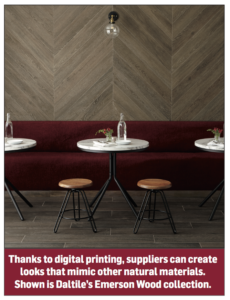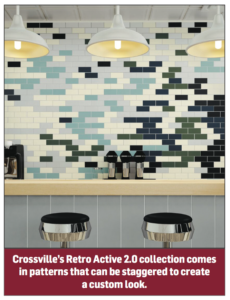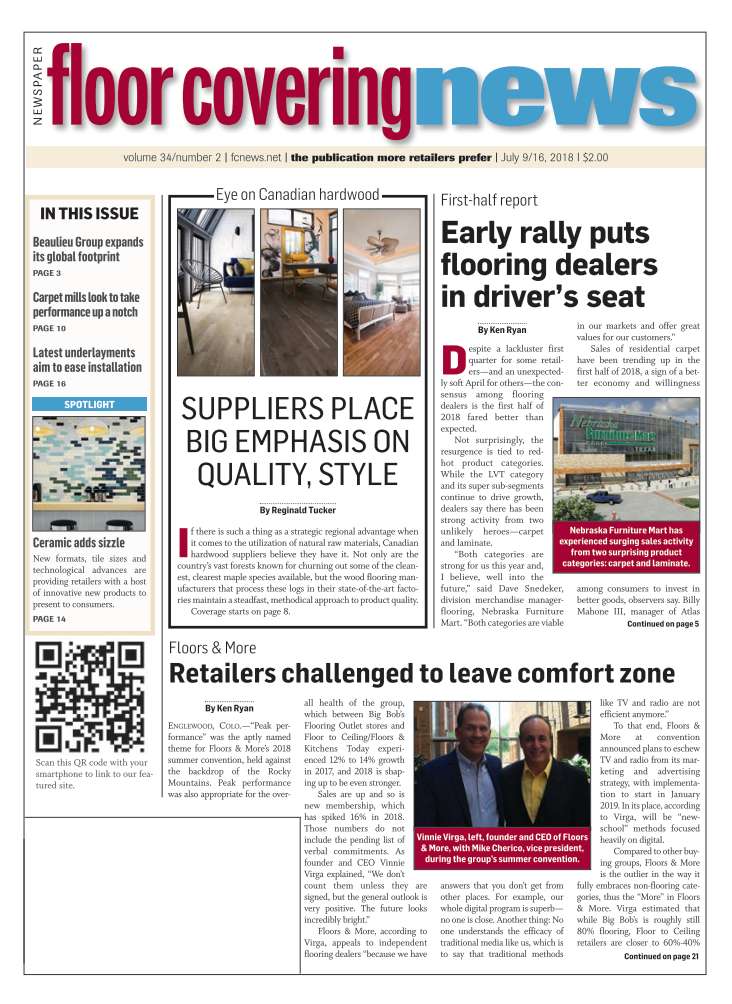July 9/16, 2018: Volume 34, Issue 2
By Nicole Murray
 Ceramic tile manufacturers continue to push the proverbial design envelope by developing new shapes, formats, patterns and sizes. The aim is to better meet the needs of a diverse and growing range of end users.
Ceramic tile manufacturers continue to push the proverbial design envelope by developing new shapes, formats, patterns and sizes. The aim is to better meet the needs of a diverse and growing range of end users.
In terms of visuals, ceramic is looking to nature for inspiration—literally. Wood planks continue to rise in popularity, based not only on the high level of realism that can be achieved due to sophisticated digital printing, but also because of the advent of longer plank sizes and wider widths.
“Playing with the different sizes side by side adds a more modern yet sophisticated element to the design because the non-linear pattern will pop as a focal point,” said Laura Grilli, senior product development manager, Dal-Tile. As an example, she cited Daltile’s Emerson Wood collection, which is available in three extra-long sized planks, including 12 x 48, 8 x 48 and 6 x 48 formats.
But it’s not just wood looks that are trending. Warm, gray-colored concrete tile, as seen in American Olean’s Union collection, is turning heads, according to the company. “There is a softness that comes through when using gray,” Grilli explained. “Once installed, end users have the option to choose a design direction ranging anywhere from minimalistic to modern.”
Industry observers also continue to track interest in larger formats. While 12 x 24 remains the staple tile size, larger options such as 24 x 48 and 18 x 36 are gaining in popularity. Proponents cite the appeal of minimal visible grout lines, which are inherent in larger tiles, to the greater floor space bigger tiles cover, particularly in more expansive settings.
Larger-format ceramic tiles are also being utilized in various indoor spaces that require a clean and professional look as well as low maintenance. “Think elevator bank walls in office buildings, exterior cladding for hotels and retail centers, feature walls in multifamily lobbies as well as fireplace surroundings in living areas with vaulted ceilings,” said Lindsey Waldrep, vice president of marketing at Crossville. “These huge pieces of ceramic tile have infinite design capabilities and are so appealing in these environments.”
 Interestingly, larger tiles are creating opportunities beyond interior settings. “Consumers are using larger panels for a monolithic look that takes tile from the front door all the way out to their patio,” said Emily Holle, director of trend and design, MSI. “Ceramic tile has proven its functionality no matter the environment, and people are taking advantage of it.”
Interestingly, larger tiles are creating opportunities beyond interior settings. “Consumers are using larger panels for a monolithic look that takes tile from the front door all the way out to their patio,” said Emily Holle, director of trend and design, MSI. “Ceramic tile has proven its functionality no matter the environment, and people are taking advantage of it.”
But that doesn’t mean smaller tiles no longer have a place in the home. Observers say miniature ceramic tile sizes are still being utilized for decorative applications such as backsplashes or accent walls. “People are much more appreciative of the handmade products these days,” Waldrep said, citing Crossville’s Retro Active 2.0 collection, which is available in 13 different colors and various shapes. “Smaller tiles allow for more options of how to use the space on the wall by playing with different shades of colors and how they are arranged.”
What’s more, using various shaped tiles allows end users to experiment with color and size in both traditional and unconventional ways. For instance, Emser Tile’s Design Form collection of 9 x 9 tiles offers 16 different black and white patterns that can be mixed to make a classic linear design or busy flooring pattern that can function as the focal point of a design.
“People are playing with irregular angles, linear etching and plaster effects to add texture and alluring dimensions on their walls,” said Barbara Haaksma, vice president of marketing, Emser Tile. “It draws in the eye so much quicker and keeps it there because there is so much to take in when the pattern is kept busy.”
Some of the most popular shapes being used on walls are fish scale, chevron and herringbone—some of which may incorporate 3D textures for a multi-dimensional look. “Our Visual Impressions collection is the perfect example of a wall tile that is not only visual but tactile and can make a space much more comfortable,” American Olean’s Grilli explained. “People are looking to take it to the next level so that you can touch and feel the texture of the tile which adds even more personality to the entire design.”
Technological leaps
Ceramic tile producers attribute many of the latest looks and designs to the advent of digital printing technology. This, observers say, has almost single-handedly ushered in the ability to create patterns and designs that at first were thought to be unrepeatable.
“Ceramic can now mimic looks that cannot be replicated in other materials,” Emser Tile’s Haaksma said. “The tile can capture textured concrete looks, mod-inspired graphic patterns and reminiscent terrazzo prints while outperforming other materials in cost and ease of maintenance.”
More specifically, printing technology has allowed marble to thrive because of the new capability to manipulate small details within the material so the design pattern can expand to more than one tile and be used in larger areas.
“Printing technology has allowed manufacturers to perfect minor aspects of the graphics that could not be achieved in the past,” Grilli explained. “For example, we are now able to adjust how one specific vein looks on a piece of marble that could not have been adjusted previously. This allows us to synchronize multiple pieces together.”
But it’s not just flooring we’re talking about here. Large porcelain slabs, such as Daltile’s Panoramic Porcelain Series, can also be used for countertop applications. “Porcelain slabs are easy to clean, waterproof, scratch-proof, cannot be stained and don’t freeze,” Grilli noted. “They are becoming the obvious choice because of the design capabilities, along with the numerous everyday advantages.”

